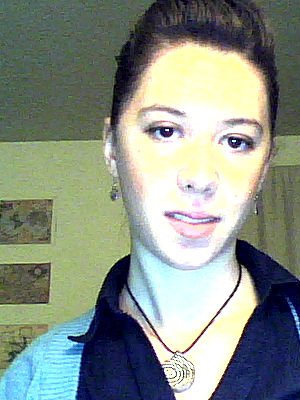I need a camera, to my eye,
to my eye, reminding
which lies I’ve been hiding
-Wilco, “Kamera”
There is profuse proof of my existence after age 10. My photographic life begins awkward, barely pre-teen. Band concerts, summer camping, middle-school portraits of me with braces, family pets, all chronologically ordered into albums; a first-hand account of myself shelved between Webster’s Dictionary and Anatomy for the Artist.
Many of my pictures are copies of my dad’s photos. Others were given to me by friends, or posted to their facebook accounts, but the majority are my own, for I am interested, like many others, in visual documentation of my life. True, I am a terrible photographer; however power lines and beater cars in the foreground of a sunset shot never stop me from remembering exactly how I felt when I stood there with the camera in the first place.
My enthusiasm for, and the undeniable popularity of photos is simple: they are more reliable than memory. We choose when to experience them, and they remind us, likely, of accomplishments or enjoyable times.
Memories can hide, they build webs connected to smells or songs, they show-up totally uninvited during dinner dates, or dance before our eyes late at night when we’d rather be sleeping.
For me, a recent episode of This American Life spontaneously unearthed a memory. The story, “Needle in a Crapstack”, by Jon Mooallem, details a day at the auction. No, not that auction–no blue-haired women in fur coats, no museum quality artifacts, and no brunch at the clubhouse afterword—I’m talking about the auctioning of defaulted upon storage units. This auction reeks of casino carpets, blacktop in august, particle board, dirt cheap flea markets. In fact, many of the regular attendees make their living selling the goods obtained from storage units at flea markets or antique stores.
To acquire a defaulted storage unit is simple: the crowd gathers, the units are opened one by one for viewing, the auctioneer begins somewhere around $50, the price flies up fast. Without looking in any boxes or handling any furniture, the purchaser buys the entire contents of the unit.
As the narrator continued, the sound of locks being cut and metal doors jangling in the background, my heart raced. It beat fast and smart, as if it knew in its electrically junctioned cells all along something my mind worked hard at forgetting.
* * *
After the foreclosure of her home, my mother packed my brother’s and my childhood photos—probably her own as well—into boxes and put them in storage with furniture and junk, kitchen supplies and extra linen. She maintained this unit throughout homelessness. She maintained it flopping from apartment to apartment and job to job and man to man and drug to drink. For me, it is difficult to determine at which point she defaulted on payment, though it must have taken about 3 years.
I could easily call my mother and ask for details. How many payments did you accidentally miss? Were you aware of what would happen or did you think you had more time? Were you moving to the house by the railroad tracks or away from it?
Do you want to ask your mother about one of her biggest regrets? I don’t. Not then, and not now. Occasionally she’s brought it up herself, with a clothes ripping, hair pulling tonal lament, “The family photos, I can’t believe I lost the family photos!” I can’t believe it either.
* * *
What I remember most vividly is not how I found out— did my mom call or were we face to face— but something I imagined: a lean, gray haired man in leather work boots carrying a large cardboard box, opening the corrugated plastic lid of one of those ubiquitous green dumpsters and heaving the box inside, school portraits of my brothers and I spilling out among torn black plastic garbage sacks, broken gadgets, and moth-eaten sweaters. Photos of my long divorced parents at their wedding, the only memory I had of them kissing, decomposing in the rain at the dump.
At the time, thoughtlessness was the only possibility. Now I create another image, a thin lipped woman in a faded floral dress calling a recently disconnected phone line, a message that would have asked my mother to retrieve her photos.
* * *
I told myself I was overreacting, and never mentioned it to my friends. They would understand what it meant to me, of course, but I was ashamed and still young enough to believe I would not be identified as separate from my mother and her life choices. Also, how could I explain what happened—I literally did not know the laws surrounding defaulted property.
8 years later on a foggy Friday night, Mooallem’s 20 minute story was answering all the questions I didn’t know I needed to ask. My throat ached with the unexpressed. One of the interviewees had, like me, lost the photographic evidence of his childhood to an auction. Now he pays his bills, like many others at the event, purchasing auctioned units and selling the contents.
It eased my mind to know that my siblings and I were not alone in both an anomalous and unlucky experience. And I believed the interviewee, his sentences warped with veiled grief, as he described taking the time to return boxes of photos to the owners when he found them among his auctioned loot. I believed something else too, something he said only in the thickness of breath between his words—that he secretly hoped one day to sort through a storage unit and find, not expensive jewelry or rare antique furniture, but photos of himself.

Mishon A. Wooldridge is a Northwest writer and massage therapist. She is currently the poetry editor at 5×5, a little lit mag. Her work has previously appeared in Floating Bridge Review, Earth’s Daughters, Third Wednesday, Jeopardy Magazine, and others. She earned a BA in Creative Writing from Western Washington University.
